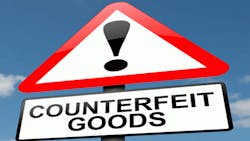The 'Ticking Time Bomb' of Counterfeit Electronic Parts
The proliferation of counterfeit electronic parts into the manufacturing supply chain costs the U.S. government and its contractors billions each year.
But the problem is not just limited to those who supply government agencies. Recent reports show consumer and industrial businesses are losing approximately $250 billion each year because of counterfeit components.
One report notes the automotive industry alone lost $3 billion in sales, while another shows the semiconductor industry takes a $75 billion annual hit.
In addition, these counterfeit parts frequently create the potential for product malfunction, leading to personal injury and even death — a situation that has created unnecessary danger for military and everyday consumers, plus immense new levels of liability and risk for manufacturers in a wide range of industries.
But there are a number of proactive steps companies in various industries may take to protect themselves from the escalating dangers posed by counterfeit electronic parts. The U.S. government and the industrial community have taken measures to combat this growing problem, and understanding the applicable regulations and industry-certified best practices is the first step to avoiding risk.
Counterfeit Protection in the Defense Sector
On November 8, 2011, the United States Committee on Armed Services held a hearing regarding an investigation of counterfeit electronic parts in the defense supply chain. The investigation had revealed alarming facts: Materials used to make counterfeit electronic parts, known as e-waste, are shipped from the United States and other countries.
The e-waste is sent to cities like Shantou, China, where it is disassembled by hand, washed in dirty river water, and dried on the city sidewalk. Parts are then sanded down to remove the existing part number or other markings that indicate its quality or performance. Subsequently, false markings are placed on the parts that lead the average person to believe they are new or high-quality parts. One industry leader testifying at this hearing called the problem a “ticking time bomb.”
Less than two months later, on December 31, President Barack Obama signed The National Defense Authorization Act for Fiscal Year 2012 into law. Section 818 of this act requires all DOD contractors and subcontractors to obtain electronic parts from original equipment manufacturers (OEMs), their authorized dealers, or from “trusted suppliers” that obtain parts exclusively from OEMs or their authorized dealers.
Section 818 covers all contractors who supply electronic parts or products that include electronic parts. DOD contractors are required, whenever possible, to obtain electronic parts that are in production or currently available in stock from the original manufacturers of the parts or their authorized dealers. In addition, electronic parts that are not in production or are out of stock must be purchased from trusted suppliers certified by an accredited certification body.
Under Section 818, contractors who know or “have reason to suspect” that they have received counterfeit electronic parts are required within 60 days to report to the appropriate government authority, the Government Industry Data Exchange Program (GIDEP). Being proactive and complying with this reporting requirement can significantly help minimize potential liability, because Section 818 bars lawsuits by the supplier of a part reported as counterfeit in situations where a reporting contractor makes a “reasonable effort” to determine whether the item contained counterfeit electronic parts.
And, surely, no contractor wants to be hit with Section 818’s strict discipline for distributing counterfeit parts. The legislation imposes monetary penalties up to $15 million — and even imprisonment — for individuals who intentionally or recklessly facilitate the availability of counterfeit goods in the supply chain.
Industry Standards Evolve
SAE International (SAE), the global standards association well familiar to the aerospace, automotive, and commercial vehicle industries, has implemented new standards to prevent the dangers associated with the growing threat of counterfeiting.
AS6081 was issued in November 2012 and was recently adopted by the DOD. This standard provides uniform requirements, practices, and methods to mitigate the risks of purchasing and supplying fraudulent or counterfeit electronic parts for distributors. According to the Defense Standardization Office, “Adoption is analogous to the ‘Good Housekeeping Seal of Approval.
This standard requires organizations involved with the purchase, acceptance, and distribution of such parts to have a quality management system in place, to communicate and document contract provisions that establish purchasing controls, and to retain appropriate records for supply chain traceability. In addition, AS6081 requires the purchased products to be verified through external visual inspections and radiological examinations.
While AS6081 covers distribution of components, AS5553A provides similar certification for manufacturers. Originally implemented in January 2013 in response to the increasing volume of fraudulent and counterfeit parts entering the aerospace supply chain, AS5553A was expanded to mitigate such risk on a global scale with regard to various sectors. Many of the requirements of AS5553A are similar to AS6081 and likewise aim to prevent the receipt and installation of fraudulent or counterfeit parts through uniform requirements, practices, and methods.
Other efforts within the industrial community are evolving to instill confidence in consumers and help companies stay ahead of the threat.
Most recently, industry veterans poured a number of years’ worth of work and countless international meetings into developing the Counterfeit Avoidance Program accredited by the International Electrotechnical Commission. This new third-party certification system allows manufacturers, distributors, and all other supply chain entities to demonstrate compliance and ongoing maintenance of their counterfeit avoidance program.
Potential Liability for Any Industry
According to the International Chamber of Commerce, 80% of consumers in the developed and developing world regularly purchase counterfeit products. However, they are usually unaware of the dangers associated with using these products.
In addition to new federal regulations, companies in practically any industry face potential liability from the proliferation of counterfeit parts because of their heightened propensity for failure. When a part is deemed the cause of severe property damage, personal injuries, and financial liability, the suppliers of those products may be held legally responsible for such accidents.
For instance, in early July of this year federal charges were filed against an individual in Massachusetts by the Justice Department for conspiracy to traffic counterfeit goods. He purchased counterfeit parts from China, then sold them to customers in the United States for use in nuclear submarines. If convicted, he may go to prison for twenty years.
The extent and particulars of liability can vary by jurisdiction, but as just one example, under Pennsylvania law one who sells a product in a defective condition that causes harm to the consumer or his property can be subject to liability even if the seller exercised all possible care in the sale of that product. Therefore, it is imperative that all suppliers of such components or parts take every possible precaution to ensure they are not distributing counterfeits and to be aware of applicable laws and regulations in the jurisdictions where they do business.
While it may be impossible to completely prevent the distribution of counterfeit parts into the supply chain, it is crucial to ensure your company and those with which it does business are working to protect themselves and their customers. Understanding and complying with federal regulations and internationally recognized standards not only contributes to ultimately reducing the availability of counterfeit parts, it also helps mitigate the associated liability risks facing organizations, even while procuring obsolete or hard-to-find product not available through the OEM or franchise distributors.
Matthew R. Shindell is Special Counsel in the law firm of Goldberg Segalla, where he concentrates his practice in the defense of product liability matters involving industrial equipment and consumer products.
Todd Kramer is CEO and co-founder of Secure Components LLC, the first company in the world to achieve an accredited counterfeit avoidance certificate in accordance with the International IECQ AP-CAP Conformity Assessment Program and the SAE AS6081 International Standard, and chairman of the Counterfeit Avoidance Mark Alliance (CAMA).
Stanley H. Salot Jr. is president and CEO of ECC Corp., the U.S.-member body for the IEC Quality Assessment System for Electronic Components, a worldwide certification program in operation since 1982.



